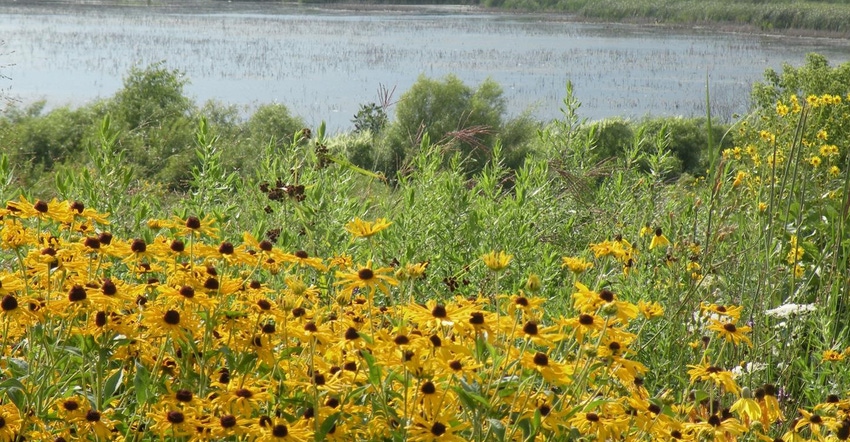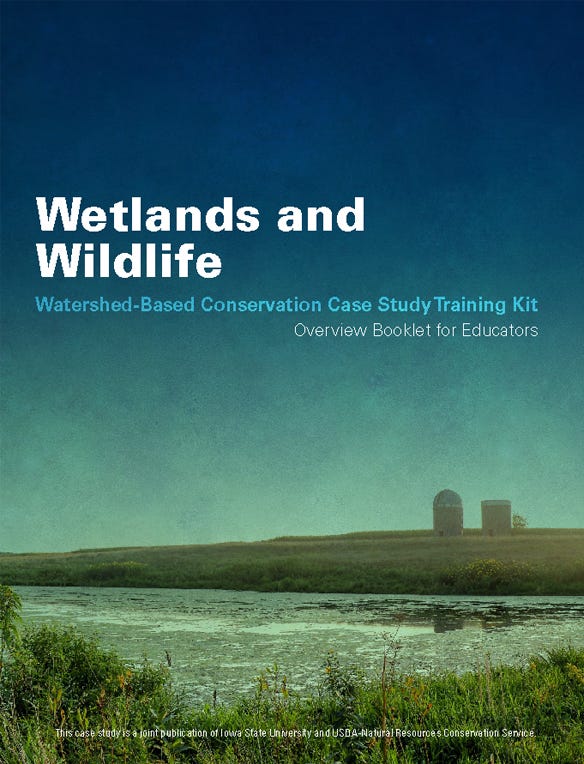July 1, 2022

Iowa has lost 90% of its natural wetlands over time. It is well understood that wetlands play a critical role in the reduction of nutrient loss and slowing water flow from farm fields to surface waterways, impacting water quality and flood control. In addition, these areas provide habitat for wildlife and support a wide range of recreational activities. Reestablishment of these natural water-filtering structures plays an important role in achieving the Iowa Nutrient Reduction Strategy goals.
A recently released case study and teaching kit from Iowa State University’s Conservation Learning Group (CLG) provides students, farmers and landowners with an opportunity to learn about practices and approaches to improving water quality and increasing wildlife habitat in Iowa through the restoration or construction of wetlands and the utilization of oxbows.
The Wetlands and Wildlife: Watershed-Based Conservation Case Study Training Kit is one of four educational packages from CLG designed for agriculture and environmental science classrooms at the high school and college levels. The case study is also an excellent tool for farmers, landowners and agriculture professionals to use in exploring what-if scenarios, and discovering approaches relevant to specific farms, fields and watersheds.
Tasks help with plan
The case study presents learners with the task of developing a wetland plan for a specific property or watershed. Students are provided with detailed information and resources to assess the motivations for the project, potential costs, funding sources and requirements, and site-decision criteria. Using these resources and independent research, users can prepare a detailed plan and estimate impacts on farm performance, water quality and wildlife implications.

Focusing on three typical wetlands found in Iowa, the case study provides scenarios for considering a restored wetland, a constructed wetland using Conservation Reserve Enhancement Program funding and an oxbow wetland.
In an Iowa Learning Farms webinar presenting an overview of this case study, Adam Janke, an ISU assistant professor and Extension wildlife specialist, noted that the team went out and surveyed the three study sites to help the students think about the benefits of wetland restoration using real-world information.
Impacts of wetlands
“Many different wildlife species in Iowa benefit from wetlands, but we focused on birds and did bird surveys of each site,” Janke said. “In the case study resources, we give the learners a list of bird species found. We also help them understand the species of greatest conservation need outlined in the Iowa Wildlife Action Plan, and distinctions between those species and what was found in each wetland site.
“To estimate the impacts of wetlands on water quality, we went to peer-reviewed literature as well as the nutrient tracking tool — a resource included in the kit — to estimate how much nitrogen and phosphorus wou
ld be addressed by the restoration or creation of these wetlands,” Janke continued. “These data and references provide a way for students to think about the impact of wetlands.”
The final impacts considered in the case study are the intrinsic benefits, such as improved recreation, aesthetic value and heightened quality of life.
“Putting wetlands on farms is a really fun way to enhance people’s experiences on farms,” Janke said. “We included this section to make sure we gave the students a couple of different tools and inputs for thinking through why it is that these wetlands may have less tangible but very important benefits to the landowners or other people that may be interacting with those wetlands.”
Tools for tomorrow’s farmers and agricultural professionals
While the case studies from CLG should be very helpful for farmers and landowners, they also provide educators with a rich set of resources to engage and challenge students looking to become part of the farming economy.
With a focus on managing profitability, each case study includes teacher and student reference materials, data sources and reports from real working farms that can be used for reference and resource. Students are challenged to make decisions to increase profitability while managing soil health, nutrient losses and wildlife impacts.
The CLG case study series serve as complementary resources to the award-winning Whole Farm Conservation Best Practices Manual, also published by CLG. Both the case study and the whole farm manual are available free of charge at the following links:
* Whole Farm Conservation Best Practices Manual
* Wetlands and Wildlife: Watershed-Based Conservation Case Study Training Kit. conservationlearninggroup.org. Look for the Training heading, then scroll down to the Educators section. The preparation of this case study was completed with support from the USDA Natural Resources Conservation Service.
Ripley is the Iowa Learning Farms manager and a Water Rocks! conservation outreach specialist.b
About the Author(s)
You May Also Like




